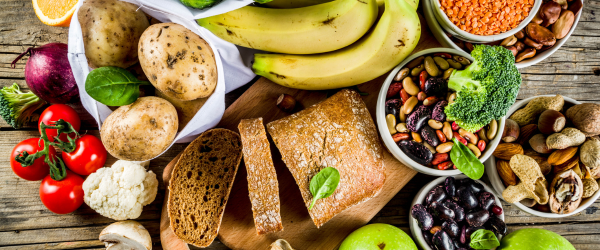Carbohydrates often get a bad reputation, but they play a crucial role in our overall health and well-being.
The main source of energy for the body, carbs help fuel the brain, kidneys, heart, muscles, and central nervous system. Carbs are not bad! Where carbs become detrimental to your health is when too much and too many processed, carb-rich foods are consumed.
On the opposite end, not getting enough in the diet can cause headaches, fatigue, weakness, difficulty concentrating, nausea, constipation, and vitamin and mineral deficiencies. Have you ever felt “hangry,” or just irritable because you’re so hungry? This is one way your body tells you you need some carbs!
In short, the quality and quantity of carb-rich foods in your diet greatly influences your health.
When you hear carb-rich, think about any food that contains ~12 grams of carbohydrates, or more, per serving. Keep in mind that not all carbs are created equal though!
Healthy carb-rich foods include those that have been minimally processed and contain fiber and other nutrients beneficial to the body. Fiber is a type of carb that the body can't digest. It helps regulate:
- Blood sugar levels (which keeps you feeling full for longer)
- Estrogen levels (reduces estrogen absorption)
- Bowel movements (decreases risk of constipation)
- Cholesterol levels (reduces absorption into bloodstream)
Examples of these healthy carb-rich, fiber-rich foods include:
- Whole grains like quinoa, amaranth, barley, brown rice, oatmeal, and whole wheat pasta.
- Beans and Legumes including lentils, black beans, pinto beans, navy beans, chickpeas and soybeans.
- Starchy vegetables such as sweet potatoes, yams, corn, and peas.
- Fruits (higher in vitamins and minerals which is why they also have their own quarter of the plate!)
The keys to making carbs a healthy part of your diet are:
- Replacing refined carbs (i.e., bread, white rice, pasta, crackers, chips, baked goods, etc.) with healthy, fiber-rich carbs.
- Spreading your carb intake throughout the day. (a good guideline: 5-10 g/snack and 30-45 g/meal)
- Never eating a carb-rich food alone! Always combine a carbohydrate with some protein or healthy fat. (i.e., apple with peanut butter or toast with avocado)
If you notice your body feels better when you omit carb-rich foods from your plate, think about filling that fourth portion with extra veggies or fruits instead!




